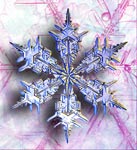 Randy Ingermanson at The Snowflake Method of Writing a Novel suggests three steps to help get a handle on your novel's (or story's) structure. I prefer writing first and then figuring out what the book is about when it's done ;-)
Randy Ingermanson at The Snowflake Method of Writing a Novel suggests three steps to help get a handle on your novel's (or story's) structure. I prefer writing first and then figuring out what the book is about when it's done ;-)But his techniques could work well when you've completed a story and are heading into the editing phase.
Step 1: Write a one-sentence summary of your story. For one thing he says this will serve as a ten-second selling tool, a hook to sell your story to an editor. But it's also a good way to get a handle on what your story is about to help you focus on what to cut and what to expand on as you're rewriting.
Some hints on what makes a good sentence:
- Shorter is better. Try for fewer than 15 words.
- No character names, please! Better to say "a handicapped trapeze artist" than "Jane Doe".
- Tie together the big picture and the personal picture. Which character has the most to lose in this story? Now tell me what he or she wants to win.
- Read the one-line blurbs on the New York Times Bestseller list to learn how to do this. Writing a one-sentence description is an art form.
Step 2: Expand the sentence into a full paragraph. He suggests one sentence to give the backdrop and story setup. Then a sentence for each turning point. [He calls them disasters.] And one sentence to tell the ending.
Step 3: Then for each character write a one page summary sheet. He suggests:
- The character's name
- A one-sentence summary of the character's storyline
- The character's motivation (what does he/she want abstractly?) [Someone suggested using the word yearn. What does the character yearn for?]
- The character's goal (what does he/she want concretely?)
- The character's conflict (what prevents him/her from reaching this goal?)
- The character's epiphany (what will he/she learn, how will he/she change?)
- A one-paragraph summary of the character's storyline
This may give you more insight into your story and you may realize you need to rewrite your one sentence summary or your paragraph. That's a good thing! As he says "it means your characters are teaching you things about your story."
If you're doing this before you write it's okay to go back and change your descriptions as the story evolves. In fact expect to.
1 comment:
really great method! have been studying and using it as a base -- it really does help to get organised!
Post a Comment